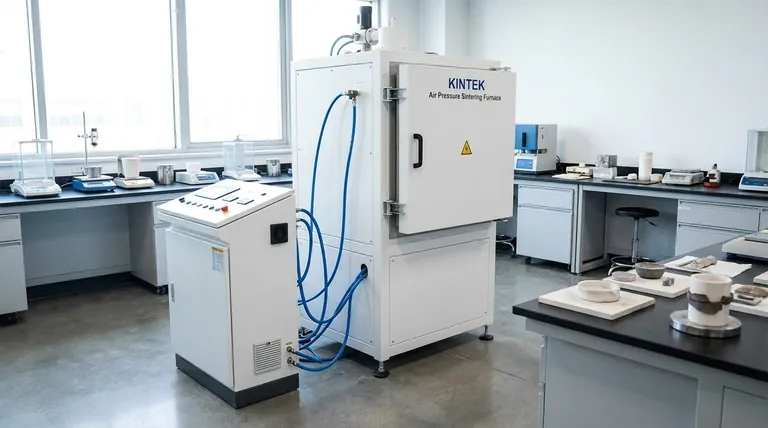Yes, fundamentally, the primary purpose of sintering is to increase density. It is a thermal treatment process that transforms a porous, loosely-packed collection of particles—often called a "green body"—into a solid, coherent mass by bonding the particles together. This process directly reduces the empty space (porosity) within the material, thereby increasing its overall density.
Sintering drives densification by using thermal energy to cause atoms to diffuse across particle boundaries. This atomic movement closes the gaps between particles, reducing the material's total volume while keeping its mass constant, which is the definition of increasing density.

The Mechanism: How Sintering Drives Densification
To understand the impact of sintering, we must visualize the process at a microscopic level, where individual particles are fused into a solid structure.
From Powder Compact to Solid Part
The starting point is typically a powder that has been compacted into a desired shape. This "green" part has mechanical strength but is highly porous, containing a significant volume of empty space between particles.
The Role of Thermal Energy
Sintering involves heating this compact to a high temperature, but crucially, below the material's melting point. This thermal energy doesn't melt the material but instead gives the atoms enough energy to move, or diffuse.
Atomic Diffusion at Particle "Necks"
Diffusion is most active at the points where particles touch. Atoms migrate towards these contact points, or "necks," causing the necks to grow and the particles to fuse together.
Pore Shrinkage and Elimination
As the necks between particles grow, the particles are pulled closer together. This action systematically shrinks and closes the pores (the voids) that were initially present. As this empty volume is eliminated, the part becomes denser and more solid.
Key Factors Controlling the Final Density
Achieving the target density is not automatic; it depends on the precise control of several key process variables.
Sintering Temperature
Temperature is the most critical factor. As noted in the reference, a specific temperature like 630°C is chosen to "achieve full density." Higher temperatures accelerate the rate of atomic diffusion, leading to faster and more complete densification.
Sintering Time
The duration of the heat treatment also plays a vital role. A longer sintering time allows for more complete diffusion, giving the material more time to close off porosity and consolidate.
Particle Size and Shape
Smaller, more uniform particles generally sinter more effectively. Their higher surface-area-to-volume ratio provides a greater driving force for the diffusion process, often allowing for densification at lower temperatures.
Understanding the Trade-offs and Limitations
While the goal is often maximum density, the process involves critical trade-offs that affect the final material properties.
The Goal of "Full Density"
"Full density" refers to achieving a density as close as possible to the material's theoretical maximum—the density of the pure, non-porous solid. In practice, reaching 100% of theoretical density is extremely difficult. A well-sintered part is often considered successful if it reaches 95-99% of its theoretical density.
The Risk of Grain Growth
A primary trade-off is with grain growth. If the sintering temperature is too high or the time is too long, the individual crystal grains within the material can grow excessively large. This can be detrimental to mechanical properties like strength and fracture toughness, even if the density is very high.
Trapped Porosity
Sometimes, pores can become isolated within the center of a growing grain. Once this happens, it becomes nearly impossible for that void to be eliminated through diffusion, placing a practical limit on the final achievable density.
Making the Right Choice for Your Goal
Controlling the sintering process allows you to engineer the final density and microstructure to meet specific performance requirements.
- If your primary focus is maximizing density for structural integrity or fluid tightness: Prioritize optimizing temperature and time to close as much porosity as possible, sometimes using pressure-assisted techniques to approach 100% theoretical density.
- If your primary focus is balancing density with mechanical properties (like hardness or toughness): Carefully control the process to limit excessive grain growth, as a fine-grained microstructure is often more important than eliminating the final fraction of a percent of porosity.
Mastering sintering is about precisely controlling atomic-level changes to achieve superior macro-level performance in your final component.
Summary Table:
| Factor | Impact on Final Density |
|---|---|
| Sintering Temperature | Higher temperatures accelerate diffusion for greater densification. |
| Sintering Time | Longer durations allow more complete pore closure and consolidation. |
| Particle Size/Shape | Smaller, uniform particles sinter more effectively, promoting density. |
| Grain Growth | Excessive growth can trap porosity, limiting maximum achievable density. |
Need precise control over your sintering process to achieve optimal density and material properties? KINTEK specializes in advanced lab furnaces and thermal processing equipment designed for reliable, repeatable sintering. Whether you're developing new materials or optimizing production, our solutions help you achieve superior results. Contact our experts today to discuss your specific lab requirements!
Visual Guide

Related Products
- Vacuum Heat Treat and Sintering Furnace with 9MPa Air Pressure
- 1700℃ Muffle Oven Furnace for Laboratory
- Laboratory Muffle Oven Furnace Bottom Lifting Muffle Furnace
- Vacuum Heat Treat and Molybdenum Wire Sintering Furnace for Vacuum Sintering
- 1400℃ Muffle Oven Furnace for Laboratory
People Also Ask
- What are the different versions of sintering? Choose the Right Process for Your Material
- What is the density of sintered material? A Design Choice for Performance, Not a Fixed Number
- What is a sintering furnace? A Guide to High-Temperature Materials Processing
- What is the impact factor of powder metallurgy progress? A 2022 Analysis & Context
- What are the advantages of vacuum sintering? Achieve Superior Purity, Strength, and Performance



















